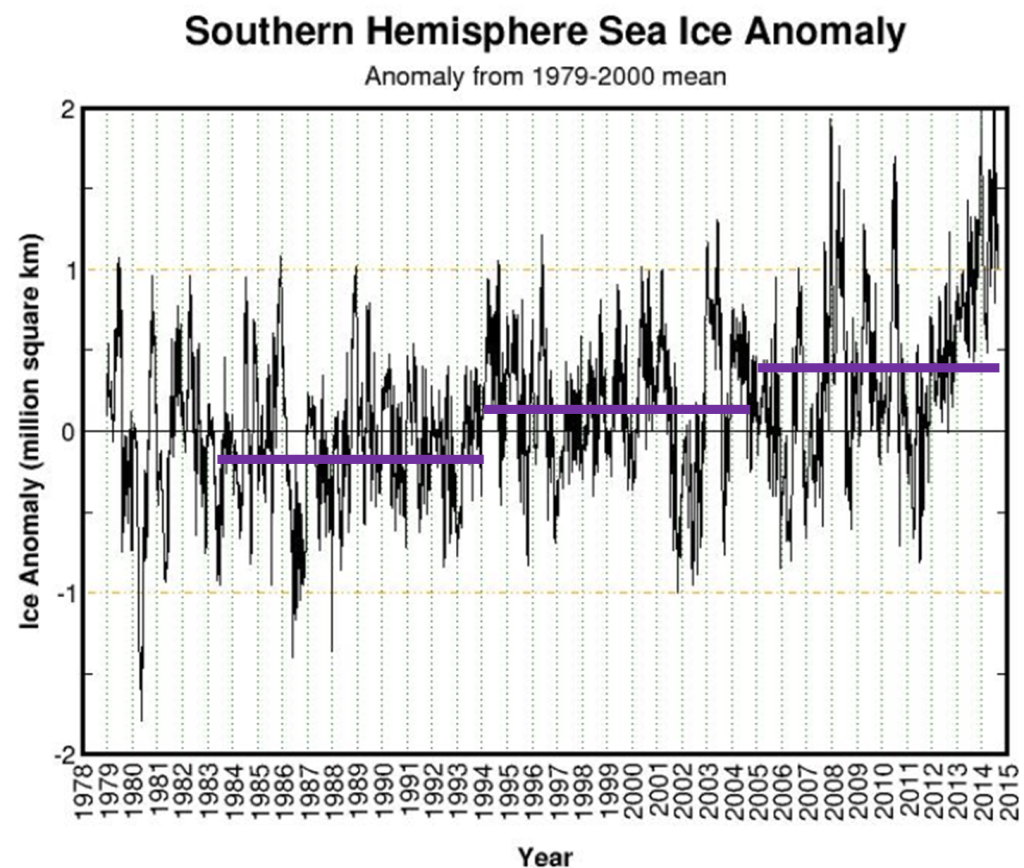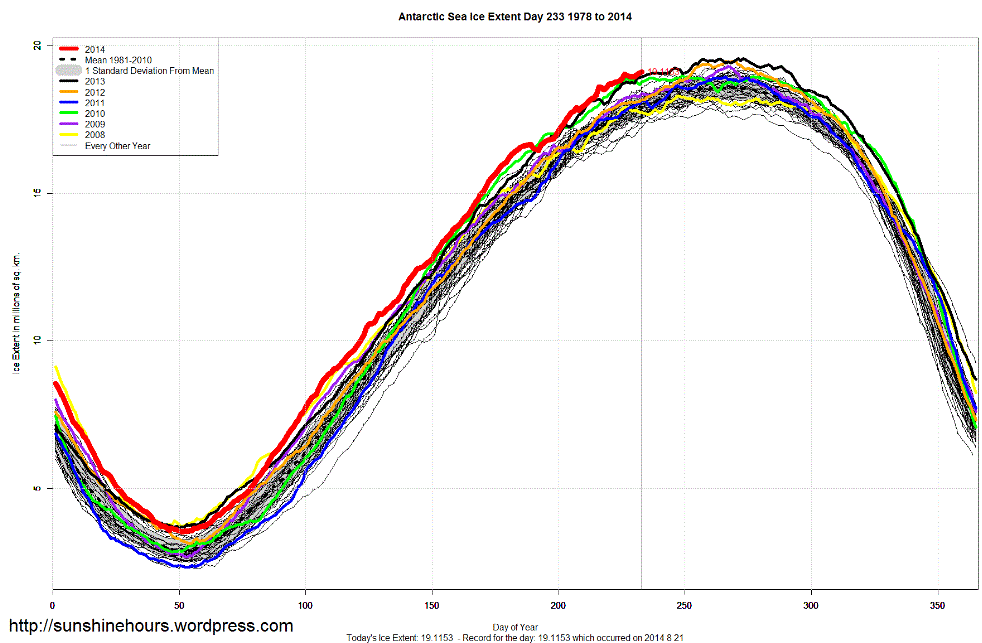Nowhere have records been falling faster than in Antarctica. And what is shocking is that these records are all tied to cooling – and not warming.
Antarctica has been setting new maximum sea ice records almost daily, and never has Antarctic sea ice been so high for so long since satellite measurements began some 35 years ago. Sea ice anomaly has averaged over 1 million square kilometers for over one year.
Figure 1: Antarctic sea ice anomaly. The mean of the past three decades has been rising for 30 years. Approximate mean bars added by author. Source: arctic.atmos.uiuc.edu
Almost daily observers of southern hemispheric sea ice have been hearing of a new record for ice extent for the date. The overall trend is not something that can be regarded as a recent anomaliy attributed to natural weather-like variability. Rather it really has to do with multidecadal trends that are unrelated to manmade CO2 emissions.
Iciest Antarctic decade ever
Figure 1 above shows how each south polar decade is icier than the one before. There is only one reason for this: There is less and less heat down there to prevent ice from forming, which seems to squarely contradict claims of a warming that is global.
In total the global (Arctic and Antarctic combined) sea ice mean for the last one and half years has been above the long-term mean. Scientists are scrambling to find out what has gone wrong with their model calculations. It wasn’t supposed to be so.
Figure 1 also shows how Antarctic sea ice has remained steadfastly above normal for more than two and half years, something that has never happened since satellite measurements began. Moreover, Anthony Watts here writes: “We are now on day 1001 of positive anomaly based on the 1979-2008 baseline.” Scientists who have long claimed the globe is warming are baffled and a few are even so shocked that they are denying it altogether.
The year of daily sea ice records
2014 for Antarctica has been especially icy. Figure 2 below shows how 2014 daily sea ice extent, depicted by the bold red curve, has been setting new record daily highs for the last 5 months.
Figure 2: Sea ice extent for 2014 depicted by red curve. Source: sunshinehours.
Not only has the sea ice area expanded at the South Pole but so has volume, this according to Germany’s Alfred Wegener Institute last October. In a German language press release the Bremerhaven-based AWI concluded that “from various studies the total volume of the Antarctic sea ice has grown over the last years.”
Record low temperatures
Not only record sea ice extent and volume are telling us that Antractica is cooling dramatically, but so are the thermometers. For example last year the National Geographic reported here that NASA had recorded the coldest temperature ever on the Antarctica continent: -136°F. Also the University of Wisconsin, Madison reported that the South Pole Station saw a new record low temperature of -73.8°C (-100.8°F) on June 11, 2012, breaking the previous minimum temperature record of -73.3°C (-99.9°F) set in 1966.
Just weeks ago CFACT reported that the British Antarctic Survey (BAS) saw a record cold of -55.4°C.
In 2010 the Neumayer III station, operated by Germany’s Alfred Wegener Institute, recorded the lowest temperature at their Antarctic location in their 29 years of operation. The mercury dropped to -50.2°C.
Antarctic freeze-up still being denied
Some global-warming-hypothesizing scientists are finding it difficult to cope with the reality of growing sea ice at the South Pole, some even insisting that it is shrinking, or that the expansion is a sign of warming and that the trend will reverse later in the future. But other experts (skeptics) think these scientists are being naive to think that a trace gas could control the entire global climate system. The climate system, they say, is far too complex and many other more potent factors are really at play. And so these experts aren’t at all surprised by what is going on.
Willie Soon, Professor of astrophysics and geosciences at the Solar and Stellar Physics (SSP) Division of the Harvard-Smithsonian Center for Astrophysics, says, “The South Pole is in sharp contradiction against the CO2 global warming scenarios which were supposed to melt most of the ice masses of the world.” So much so, Soon says, that “it is still being denied by some professional scientists“. Soon says that the freezing of the South Pole is “one fact that shows how much more we need to understand about how the Earth climate system can vary naturally and how different regions are inter-related to each other rather than insisting that all changes and variations must be caused by rising atmospheric CO2 alone.”
Antarctic sea ice should retreat when PDO and AMO cool
Veteran meteorologist Joe Bastardi, who specializes in providing commercial clients with short-term and seasonal forecasts, also thinks other major global factors are at play – for one: ocean surface temperature oscillations in the Pacific and Atlantic, i.e. the Pacific Decadal Oscillation (PDO) and the Atlantic Decadal Oscillation (AMO): “The southern oceans around Antarctic are cool in a warm PDO, but warm in a cool PDO.”
Bastardi believes that once the PDO is well into the cool phase, the Antarctic sea ice will retreat. “If the southern ice cap does not shrink, then that will be a problem, but I have confidence it will.”
But Arctic will recover
Conversely Bastardi thinks that as the AMO enters its cool phase, in about 5 -10 years, the Arctic will be well on its way to recovery. Already we see signs of that starting today. Joe has written an entire essay on this, and it will be posted tomorrow.
In summary: While scientists who have invested careers in tying climate change to CO2 are scrambling to explain the lack of cooperation by the sea ice at the South Pole, other experts think the anomaly is all part of longer term natural cycles which man is powerless to stop.







Sorry if it’s a little on the long side, but thought it’s necessary to include some expert opinions.
Don’t you dare be sorry. The in depth reporting is needed.
As the process of freezing takes place the released thermal energy has to be going somewhere (into the atmosphere? – the temperature thereof should increase.) Perhaps that phase transition energy is radiated directly out of the Earth-system and doesn’t influence local air temperature.
I’ve not encountered a report about this.
———————————————-
Terminology can sometimes be fuzzy.
Antarctica is classed as a continent.
Details, details – I know; please excuse me.
The term Antarctic seems to mean the Antarctic region that includes the continent and the surrounding Southern Ocean.
Thus, it is the ice on the Southern Ocean that is expanding and being discussed in this post. [Land ice is not the issue here.]
Wording such as “growing sea ice at the South Pole” presents an image more fitting for the ice on the Arctic Ocean.
The South Pole is many km. from the ocean and is nearly 3,000 m. up.
———-rant over———
You’ll want to watch Joe’s Sat Summary!: http://www.weatherbell.com/saturday-summary-august-23-2014
Funny old world. Cold records going down like skittles, yet only a couple of days ago I saw yet again in some rag (Guardian, Independent, who cares) that this was “the hottest year / decade evah” (can’t be sure which, I’d stopped reading). And then, this morning, the BBC’s weather forecast, supplied by the ever-warmin’ Met Office, told us we could expect … frost, in rural areas up the spine of the UK, tonight. In August. Current temp in this Midlands city, two hours before sunset, 13°C – not a day for sitting in the garden, August or no.
Y’know, increasing ice records distinctly suggest to me a cooling world, not the hottest anything. Obviously I need to brush up on my Post-Normal Science.
I do not think Antarctic Sea Ice will be shrinking in response to a cold PDO.
Antarctica unlike the Arctic is surrounded by water and therefore not subject to changes in oceanic phases or circulations as much as the Arctic is.
Going forward LOW PROLONGED SOLAR ACTIVITY will likely keep Antarctic Sea Ice above normal regardless if Arctic Sea Ice expands which is likely.
Joe always looks into the past to come up with his predictions. We see the artic/antarctic jigsaw pattern; ice area is growing on one pole while it’s shrinking on the other. We don’t know the physical mechanism; it’s just an observation of a “magical teleconnection” (or, an emergent phenomenon).
…seesaw pattern, not jigsaw pattern…
Peculiar is that CO2 is 400 ppm and H2O is almost absent as a GHG, so you would expect that minmimum temperature records are no longer possible. One conclusion can be drawn that the GH effect of CO2 is minimal and/or natural variability is more dominant.
“South Pole Station saw a new record low temperature of -73.8°C (-100.8°F) on June 11, 2012, breaking the previous minimum temperature record of -73.3°C (-99.9°F) set in 1966.“
It gets much colder at the pole. The lowest was −82.8 °C (−117.0 °F) on June 23, 1982.
There was a lot of confusion on the internet about that record. I think it was the earliest that it had got to -100 degrees F, which would be a daily record as well.
So much for that.
It was actually on April 7, 2012 that the record for earliest minus 100 degrees Fahrenheit (minus 73.3 degrees Celsius).
I really don’t know what record was set on June 11, 2012.
http://antarcticsun.usap.gov/features/contenthandler.cfm?id=2643
There are Cold Temp Records being set in quite a few places at the moment,
Ireland, USA and Australia.
These are particularly worrying
http://sunshinehours.wordpress.com/2014/08/23/noaa-1025-low-max-records-broken-from-aug-1-to-aug-21-some-by-16f/
http://sunshinehours.wordpress.com/2014/08/23/noaa-184-low-min-records-broken-from-aug-1-to-aug-21-some-records-demolished-by-11f/
It is Tiiiime….
https://www.youtube.com/watch?v=6FjI-pYFUOQ
(Ice Planet, 2001, Canada, Pilot for a TV series that didn’t come to pass)
Just a few days ago we had this headline from the BBC.
They just won’t leave it be. This sensational garbage was dealt with over at WUWT.
The strike tag did not work in my last comment.
The 0.159 should have a strike line through it, as that is how it appeared in the WUWT post.
“And so, the loss of —– 159 cubic kilometers…..”